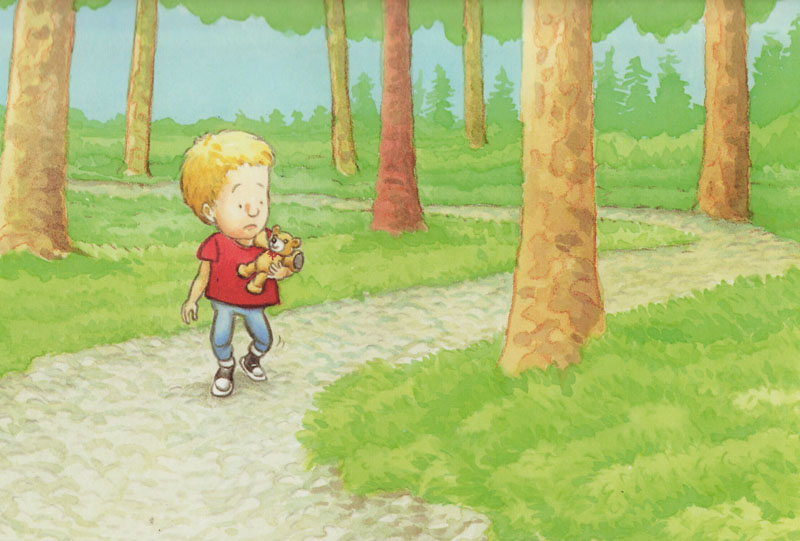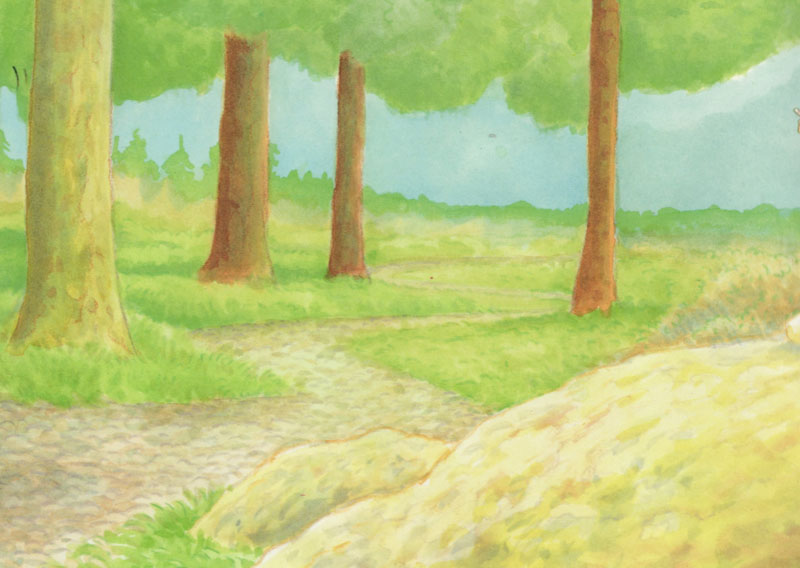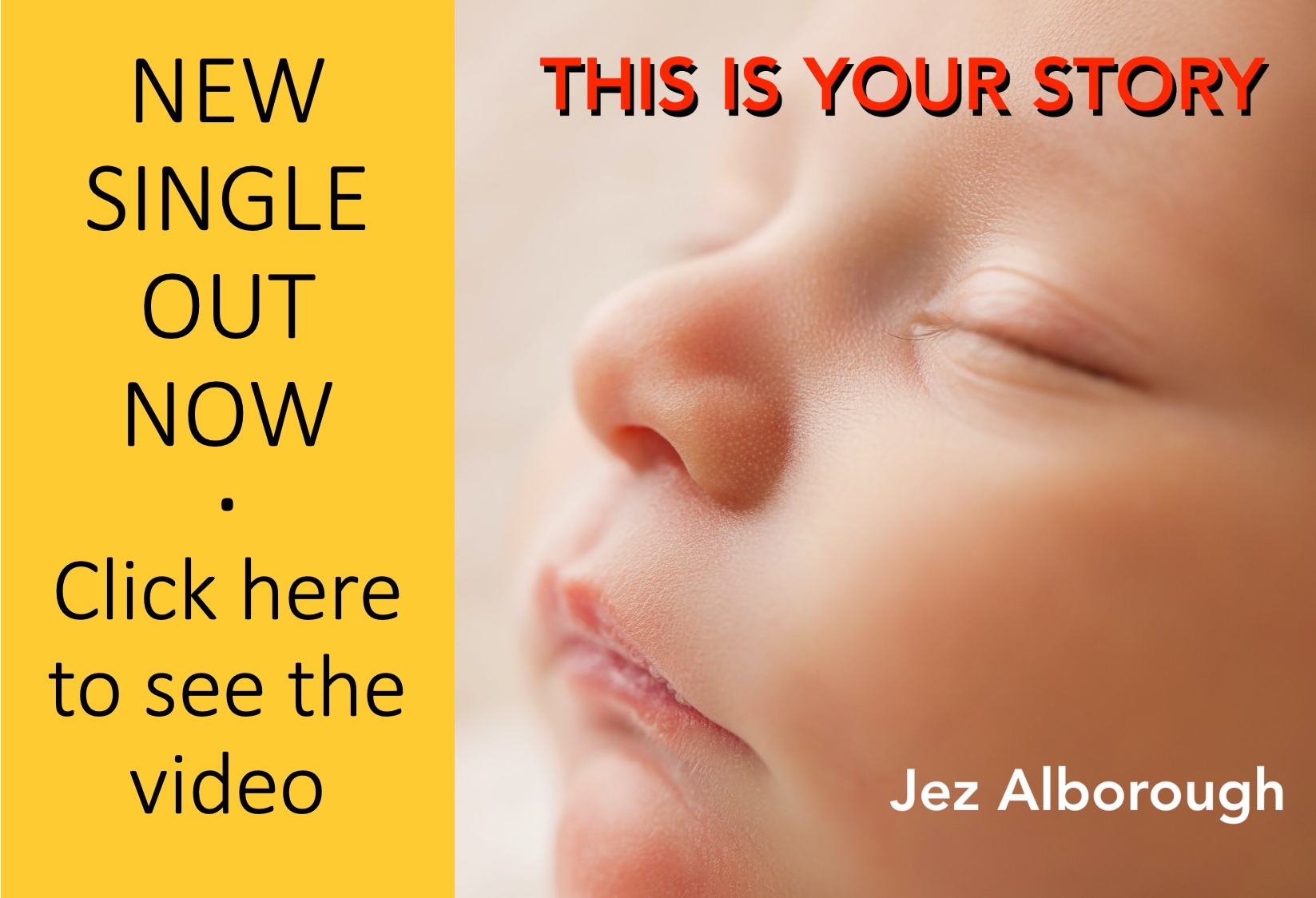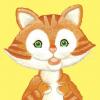CREATING MY BOOKS

About the Idea
The idea sprang from a scene I wanted to put into It's The Bear. In this scene Eddy hides from the approaching Bear in the basket but his teddy is left outside - so when Eddy speaks the Bear, not able to see him, thinks it is the teddy speaking. Your characters have to act in character for the story to be believeable and it seemed just the sort of mistake that my great big dumb, loveable Bear would make.
I found that the scene didn't fit into the story of It's The Bear. Nothing should interfere with the clear progression of a story - anything extraneous has to be cut. A good scene in the wrong story becomes waffle.
But the scene wasn't wasted. Years later, in the Channel Tunnel coming back from France, it popped back into my head for some reason and, playing around with it, I felt that tingle I get when I know that an idea has the potential to grow into a book. Speeding through the darkness of a tunnel, buried underneath the sea between England and France, was the strangest setting for this to happen. In retrospect I think it influenced the idea because originally I had Eddy venturing into the dark of the Bear's cave and finding the giant teddy. I felt that this was out of character for Eddy - it would be too scary for him - and also the darkness of a cave would have been too dark and gloomy a backdrop for the pictures so I decided Eddy should find the giant teddy bear outside in the woods. Unlike in It's The Bear I had no basket to hide Eddy in so I had him hide behind the giant teddy.
The Mis-hear Joke (Bear-farce)
It is interesting how with a joke you run with it as long as you can, squeezing out as many laughs from it as you can find, until you resolve it with the punchline: the revelation (to the Bear) that it is Eddy's voice - not the teddy's. Of course the readers (and the read to) know all along that it is Eddy’s voice and it is being in on this information which offers the potential for laughs.
If you think about it, there is another way the joke could have been played out: with us not knowing that Eddy was there, so there was a mystery - whose voice is it ? - so the readers would get the same revelation as the Bear when Eddy was seen. In the end you go for the version which has the most laughs (and fits in to your story).
The Idea Develops into the Story
Of course to have a good joke is not enough. For me the jokes of a stand-up comedian can never be as potent as a joke which is used in the setting of a story and is used to develop that story. The setting and emotions of the story bring more weight and meaning to the joke.
I had to decide what my story was. In the previous two books Eddy had met the Bear but in each case had ended up running way from him. I knew I could not end the book in this way so this led me to a scenario where they meet and don't run away.
I had a feeling that Eddy had no brothers or sisters and neither did the Bear. I liked the idea that these characters were from different worlds (species) but both were experiencing the same feeling of slight loneliness. They both had their teddies but they were getting a little older and needed more interaction than an inanimate teddy could give them. (I later found that this is a recognised stage of child development called socialisation).
That each was having the same problem and each was the answer to the other's problem seemed a perfect solution - they could become friends. In this way I discovered that the theme of the story was friendship.
For a book to work it has to be true to its subject matter. I knew that to make the story work Eddie and the Bear's friendship had to be believable. They couldn't just meet and suddenly become friends - this is not how it happens. There has to be a rapport - a sharing of experience which attracts people together. In this case initially there was the fact that both Eddy and the Bear felt a loneliness which couldn't be filled by their teddies. I think there is a vulnerable stage where you have to reach out to the other and you don't know what their response will be - they may reject you. It is Eddy who does this - by telling the Bear he is lonely.
But this wasn't enough - and this is where the joke comes in. The reveal of Eddy is a turning point - they share the shock of being revealed to each other and the reaching out could have dissolved into fear and running away. But knowing I wanted this book to be about going beyond that fear, I had to bring them closer together. I felt that if they could laugh together they would be on their way to bonding - and this is when I realised that Eddy should laugh at the Bear's mistake.
I wanted that sort of laughter where, even though it's a bad idea, you can't help yourself. The funny bone is being tickled even though the mind is saying, "Don't laugh at him, he may get angry." Like when you're at school and you get the giggles in class - and you know you shouldn't laugh and that makes you laugh even more.
It is a pivotal moment because, having gone through the fear stage, now the Bear could get angry. Of course Eddy's laughter at the Bear could not in any way be nasty, but a hurt Bear could easily take it that way. It takes the Bear to swallow his pride (in a sense, expose his silliness, be vulnerable) be willing to laugh at himself for them to really start coming together by sharing the laughter.
To show there was no superiority from Eddy (friendship should be equal) I wanted him to show that he could be silly too, which he does by pretending to be his teddy and finally the dancing and singing together. It is only when they say goodbye that they cross the barrier of touch - by sharing a hug. I feel this can only happen because they have earnt each other's trust and, I hope, it makes the hug all the more poignant that it is demostrative of their feelings for each other. It is a not a gratuitous hug, getting a cheap 'Ahh' from the reader, it is there as the crescendo of the theme (friendhip) of the story.
Having the Bear make friends with a boy seemed a good symbol for me of how friendship can cross boundaries - not only of race, religion etc but of species!
Backgrounds
There are changes between the books. In My Friend Bear I decided to make the backgrounds softer - by doing this the foreground action stands out more. It is a technique used in animation. You want to create a feeling of the scene, yet not draw people's attention to it too much. It has to do its job very quietly. It means that you have to try to capture the essence of a tree or a rock, without going into unnecessary detail. I was inspired by looking at the painted backgrounds used for Warner Brothers films like Bugs Bunny. Of course in animation there are people who specialise only in backgrounds.
It gives the book a very soft, gentle feel and focusses the eye where you want it to go - in a sense it makes the book easier to read visually.

Find out more about My Friend Bear in the JezAlborough.com Library:
NEW ON THE SITE
HAVE YOU SEEN?

















